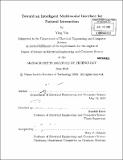| dc.contributor.advisor | Randall Davis. | en_US |
| dc.contributor.author | Yin, Ying Ph. D. Massachusetts Institute of Technology | en_US |
| dc.contributor.other | Massachusetts Institute of Technology. Dept. of Electrical Engineering and Computer Science. | en_US |
| dc.date.accessioned | 2011-01-26T14:30:53Z | |
| dc.date.available | 2011-01-26T14:30:53Z | |
| dc.date.copyright | 2010 | en_US |
| dc.date.issued | 2010 | en_US |
| dc.identifier.uri | http://hdl.handle.net/1721.1/60826 | |
| dc.description | Thesis (S.M.)--Massachusetts Institute of Technology, Dept. of Electrical Engineering and Computer Science, 2010. | en_US |
| dc.description | Cataloged from PDF version of thesis. | en_US |
| dc.description | Includes bibliographical references (p. 73-76). | en_US |
| dc.description.abstract | Advances in technology are enabling novel approaches to human-computer interaction (HCI) in a wide variety of devices and settings (e.g., the Microsoft® Surface, the Nintendo® Wii, iPhone®, etc.). While many of these devices have been commercially successful, the use of multimodal interaction technology is still not well understood from a more principled system design or cognitive science perspective. The long-term goal of our research is to build an intelligent multimodal interface for natural interaction that can serve as a testbed for enabling the formulation of a more principled system design framework for multimodal HCI. This thesis focuses on the gesture input modality. Using a new hand tracking technology capable of tracking 3D hand postures in real-time, we developed a recognition system for continuous natural gestures. By nature gestures, we mean the ones encountered in spontaneous interaction, rather than a set of artificial gestures designed for the convenience of recognition. To date we have achieved 96% accuracy on isolated gesture recognition, and 74% correct rate on continuous gesture recognition with data from different users and twelve gesture classes. We are able to connect the gesture recognition system with Google Earth, enabling gestural control of a 3D map. In particular, users can do 3D tilting of the map using non touch-based gesture which is more intuitive than touch-based ones. We also did an exploratory user study to observe natural behavior under a urban search and rescue scenario with a large tabletop display. The qualitative results from the study provides us with good starting points for understanding how users naturally gesture, and how to integrate different modalities. This thesis has set the stage for further development towards our long-term goal. | en_US |
| dc.description.statementofresponsibility | by Ying Yin. | en_US |
| dc.format.extent | 76 p. | en_US |
| dc.language.iso | eng | en_US |
| dc.publisher | Massachusetts Institute of Technology | en_US |
| dc.rights | M.I.T. theses are protected by
copyright. They may be viewed from this source for any purpose, but
reproduction or distribution in any format is prohibited without written
permission. See provided URL for inquiries about permission. | en_US |
| dc.rights.uri | http://dspace.mit.edu/handle/1721.1/7582 | en_US |
| dc.subject | Electrical Engineering and Computer Science. | en_US |
| dc.title | Toward an intelligent multimodal interface for natural interaction | en_US |
| dc.type | Thesis | en_US |
| dc.description.degree | S.M. | en_US |
| dc.contributor.department | Massachusetts Institute of Technology. Department of Electrical Engineering and Computer Science | |
| dc.identifier.oclc | 697282505 | en_US |
